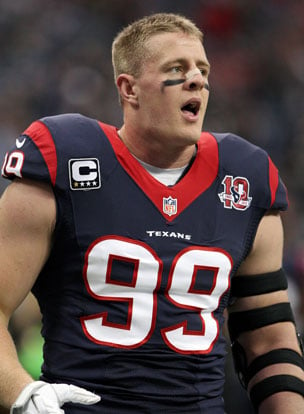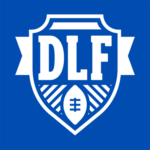Diary of an IDP Rookie
 If starting to do dynasty football is the difference between renting a car and owning a car, then venturing into the world of IDP dynasty football is the difference between owning a car and running a car dealership. There is a quite the leap that is involved when you join the world of IDP, but if you ask any of our IDP veterans, there’s no turning back once you do it!
If starting to do dynasty football is the difference between renting a car and owning a car, then venturing into the world of IDP dynasty football is the difference between owning a car and running a car dealership. There is a quite the leap that is involved when you join the world of IDP, but if you ask any of our IDP veterans, there’s no turning back once you do it!
I’ve been doing dynasty football for seven years now and I’ve always been a little scared off by the idea of IDPs. This winter we, the DLF Team decided to start up two team only dynasty leagues. One of them was your standard PPR league, while the other was going to be a full IDP league (eight offensive starters and nine defensive starters). I originally signed up for the PPR league since that was my comfort zone and I figured I could be competitive in that league. Then the IDP league was a few people short and they asked if anyone wanted to do both. I figured it would be a good learning experience, so I threw my name in the ring.
I didn’t have a clue what I was getting myself into!
This is the first part of a multiple part series that will look at and reflect upon my rookie venture into an IDP league. I’ll be the first to admit I’m going to make mistakes and I’m going to do some foolish things over the course of this first year. However, it is my hope that by sharing my experiences and thoughts as I go through this process it will help out some of you who are thinking about also making the jump – that way you can learn from both the things I did right as well as the items I completely messed up.
Here’s a little bit of background on the league before I get into my pre-draft process and explanation of my thoughts. The DLF IDP league is a 12 team league with a fairly wide range of owners. We, of course, have our IDP experts in the league, a few people who have some experience in IDP leagues, and a small handful like myself that are trying the format for the very first time. While I’m sure our experts will answer general questions, I don’t expect for a second they’ll go easy on any of us rookies. The gloves are off, so to speak.
For rosters, we are going with 44 players. There are eight offensive starters broken down in the following way: 1 QB, 1 RB, 1 WR, 5 flex (RB/WR/TE). On the defensive side of the ball, we are going with nine starters broken down as follows: 1 DT, 2 DE, 1 LB, 1 CB, 1 S, 3 flex (anything except DE).
The scoring for the offensive side of the ball is standard PPR scoring with return yardage points as well a tight end premium (1.5 PPR). On the defensive side of the ball, linemen get 2.5 per solo tackle, a one point bonus if it is a tackle for a loss, 2.5 for every half sack and a 0.1 bonus for every yard the team losses by that sack. Other defensive players receive 1.5 points per solo tackle. All defensive players get 2.5 points for a pass defensed and five or six points per turnover with the points for a fumble being split between forced fumble and fumble recovery.
Now that we are all on the same page, here was my approach and pre-draft plan. Going into it, I knew I had the eleventh pick in the draft.
Step 1: Figure out where I should start drafting IDPs
This might have been one of the biggest questions I needed to answer. For example, I knew JJ Watt was the top defensive player, but I didn’t have a clue where he should go in a startup. In order to help with this, I looked at two things. The first was a few other IDP startup drafts that have been done recently. The second was looking at the number of points scored. If you look just purely at the points scored, the argument could be made for Watt to be drafted in the top half of the first round. However, that didn’t seem to be the case in other startups. He was going after the elite quarterbacks, elite tight ends, the top 10-15 running backs and the top 10-15 wide receivers – that made him a target for my late third round pick.
As for the rest of the IDP players, it seemed to be much later. Other than Watt, I didn’t really see many other defensive players until the seventh round at the earliest. Starting in that round, you started to see a sprinkling, mostly of linebackers and defensive ends. Looking at the points scored, I didn’t really see much of a difference between the fifth linebacker and the fifteenth. When you combine that with the talent level still available on the offensive side of the ball, I decided to wait until at least my ninth pick before I would start taking defensive players. By that point in time, I would have a total of six running backs/receivers, a quarterback, and one of my top four tight ends due to the tight end premium (preferably Jimmy Graham or Jason Witten). Then I could focus largely on defense over the next eight to ten rounds while having a solid offensive lineup.
Step 2: Figure out the positional differences on defense as well as major drop offs with our scoring
Since this is what I call a “Full IDP” league where we are required to start both a cornerback and a safety instead of just a defensive back, I figured I needed to have a really good hold on the differences between the positions. I also wanted to figure out if there were major drop offs within a position and where they were. Here are my initial thoughts on the various positions. Some of these might be way off, but these are the thoughts I am carrying into the startup draft.
Defensive Tackles – Very low scoring and outside of Geno Atkins, pretty much all the same. I can wait until somewhere in the 30+ round range to take one and a second one towards the end. They seem almost like the defensive version of kickers, but not quite that bad.
Defensive Ends – Getting Watt would give a very nice advantage over the rest, kind of like getting an elite tight end. Other than that, I’m targeting players who are 4-3 defensive ends and that should approach ten sacks with 40 or more tackles. I’ll probably let others reach for the big names, but try to start getting a few defensive ends in the early to middle teens since there seems to be a pretty steady drop off in them. Since we can only start two and they can’t be a part of the flex for some reason, I plan on taking three in the teens or early twenties and then one or two fliers at the end.
Linebackers – To me, these seem to be the heart and soul of your IDPs. They are kind of like the running backs and wide receivers rolled into one. With a scoring system geared slightly towards tackles, this becomes even more true. Once I started taking IDPs, I planned on taking linebackers early and often, targeting the tackle heavy middle/inside linebackers. With one required and three defensive flex players, I want to be able to start four linebackers all season long.
Cornerbacks – These seem to be the weaker half of the defensive backfield. A big part of it is the best ones very rarely get the ball thrown their way. There also seems to be a fairly steep drop off at the position through the top 15 or so before it levels off – that tells me it is fairly important to grab one of the top few. I’m targeting players who are turnover machines and are involved in a lot of tackles instead of pure coverage players. Someone like Charles Tillman, Janoris Jenkins or Cortland Finnegan would be ideal. In later rounds, I’ll probably target players who also do some returning.
Safety – The big brother of the defensive backfield. It also seems a little bit top heavy, but the average is higher than the cornerbacks due to safeties being more tackle focused. If we just started defensive backs, I would probably ignore the cornerback position for the most part. I plan on drafting a few safeties because they are the likely flex play if I can’t slot a linebacker in there due to their consistency.
Step 3: Develop a rough game plan
Now that I have an idea of where they fit in among the standard offensive players, I can develop a nice game plan. This plan is both for where I should take players as well as how many of each I would like to see on my final 44 player roster.
On my final roster I would like the following:
20 offensive players made up of 2-3 QBs, 3-4 TEs, and the rest RB/WRs.
24 defensive players made up of 2 DTs, 3-4 DEs, 3-4 CB, 4 S, and the rest LBs
I’m fine with a slightly more lopsided roster towards defense because I trust myself to pick better on offense. I’m also planning on going very linebacker heavy because I feel like the three defensive flex positions need to be linebackers.
For a general plan for the draft, here is my rough idea:
First ten rounds – Almost all spent on offense, including a quarterback and a tight end.
Rounds 11-20 – Majority on defense, focusing on linebackers early, defensive ends a little bit late, with maybe a sprinkling of defensive backs or offensive players who I feel are slipping.
Rounds 21-30 – This should be about half and half for offensive and defensive players. I’ll continue to take a linebacker every once in a while but also round out my offensive players and defensive backfield.
Rounds 31-44 – Finally address defensive tackle. Round out the rest of my roster with young players or 32+ year old veterans that can produce this year to give some depth and production.
That about does it for my pre-draft approach to my first IDP experience. I don’t plan on doing much if any trading in this startup because I don’t feel like I know enough to make significant moves in this format. I plan on just taking what comes to me and seeing how it goes. I’ll be back after my draft is complete to give any insights that I gained. For those of you with IDP experience, feel free to add some points for myself and anyone else that is just starting on this journey. Maybe together we can help make the transition as positive as possible for those making the leap.
Wish me luck!
- Final 2021 Pre-Draft Rookie Mock: Round Three - April 28, 2021
- Final 2021 Pre-Draft Rookie Mock: Round Two - April 26, 2021
- Final 2021 Pre-Draft Rookie Mock: Round One - April 25, 2021


































































